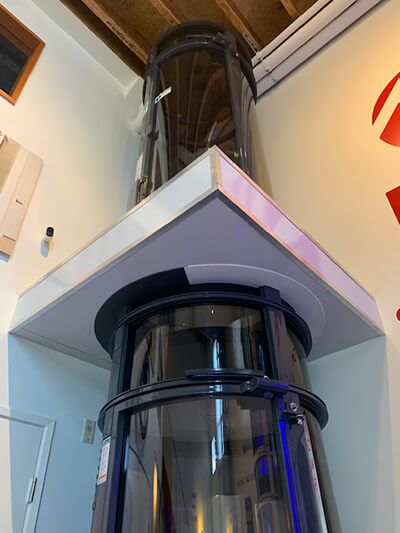It is the bustling landscape of modern architecture and urban living. Now the concept of air-driven residential elevators has emerged as a revolutionary solution to vertical mobility challenges. This innovative technology propels by the power of compressed air. It offers a myriad of benefits that redefine the traditional perception of home elevators.
Understanding the Essence of Air-Driven Residential Elevators
At the heart of this cutting-edge system lies a simple yet ingenious principle. Harnessing the force of air pressure differentials to facilitate smooth and efficient vertical transportation within residential spaces. Unlike conventional elevator mechanisms reliant on cables, pulleys, or hydraulics, air-driven elevators operate on the fundamental principles of pneumatics.
The Mechanics Behind Air-Driven Elevators
In essence, an air-driven residential elevator comprises a cylindrical chamber. It is typically of lightweight materials such as aluminum or reinforced plastics. This chamber serves as the primary carriage for transporting passengers or goods between different floors of a building.
Within the elevator shaft, a network of pneumatic tubes facilitates the flow of compressed air, generating the necessary propulsion to move the elevator car vertically. By regulating the air pressure differentials within these tubes, precise control over ascent and descent comes. It ensures a smooth and stable ride experience.
Key Advantages Over Conventional Elevator Systems
1. Space Efficiency and Versatility
One of the most notable advantages of air-driven residential elevators is their compact footprint and versatile installation options. Unlike traditional elevators that require extensive shaft space and structural modifications, air-driven systems can seamlessly integrate into existing buildings with minimal space requirements.
2. Energy Efficiency and Sustainability
By harnessing the power of compressed air, these elevators offer unparalleled energy efficiency compared to their conventional counterparts. Unlike hydraulic systems that rely on continuous power consumption to maintain pressure, air-driven elevators consume energy only during operation, resulting in significant savings in long-term operational costs.
3. Quiet and Smooth Operation
The absence of mechanical components such as cables and pulleys eliminates the need for lubrication and reduces friction, resulting in whisper-quiet operation and minimal vibration. This not only enhances the overall user experience but also contributes to a tranquil living environment, particularly in residential settings where noise pollution is a concern.
4. Safety and Reliability
Air-driven residential elevators have a strong emphasis on safety and reliability. The use of redundant fail-safe systems, such as emergency braking mechanisms and pressure sensors, ensures optimal performance under various operating conditions. Additionally, the absence of hydraulic fluids eliminates the risk of leaks or environmental hazards, further enhancing safety standards.
Real-Life Applications and Case Studies
To illustrate the practicality and efficacy of air-driven residential elevators, let us delve into real-life applications and success stories within the realm of modern architecture and urban development.
Case Study: The Green Tower Residence
Located in the heart of a bustling metropolis, the Green Tower Residence stands as a testament to sustainable urban living and innovative design. Seeking to minimize its environmental footprint while maximizing resident comfort, the developers opted for air-driven elevators as a core feature of the building’s vertical transportation system.
By integrating air-driven elevators into the architectural blueprint, the Green Tower Residence achieved a perfect synergy of form and function. Residents enjoy seamless access to different floors, while the building’s carbon footprint is significantly reduced thanks to the energy-efficient nature of the elevator system.
Future Prospects and Technological Advancements
As technology continues to evolve and innovate, the future prospects for air-driven residential elevators appear promising. Ongoing research and development efforts aim to further enhance the efficiency, reliability, and safety standards of these elevators, paving the way for their widespread adoption in residential and commercial settings alike.
In conclusion, air-driven residential elevators represent a paradigm shift in vertical transportation technology, offering a host of advantages over conventional elevator systems. From their space-efficient design to their energy-efficient operation and silent performance, these elevators embody the principles of innovation and sustainability. As urban landscapes evolve and architectural boundaries are pushed, air-driven elevators stand poised to redefine the way we ascend and descend in the world around us.
Overcoming Challenges and Addressing Concerns
Despite their numerous advantages, air-driven residential elevators are not without challenges and concerns. It is imperative to address these issues to ensure widespread acceptance and adoption of this innovative technology.
1. Initial Investment Costs
One of the primary concerns surrounding air-driven residential elevators is the initial investment costs associated with installation. While the long-term operational savings are undeniable, the upfront expenses may pose a barrier to entry for some homeowners and developers. However, advancements in manufacturing processes and economies of scale are gradually driving down the cost of these elevators, making them more accessible to a broader market.
2. Maintenance and Service Requirements
Like any mechanical system, air-driven elevators require regular maintenance and servicing to ensure optimal performance and safety. While the absence of hydraulic fluids simplifies maintenance to some extent, specialized knowledge and expertise may be necessary for troubleshooting and repairs. Establishing robust maintenance protocols and partnering with reputable service providers can mitigate these concerns and prolong the lifespan of the elevator system.
Regulatory Compliance and Safety Standards
As with any form of vertical transportation, air-driven residential elevators are subject to stringent regulatory requirements and safety standards. Ensuring compliance with local building codes, elevator regulations, and industry standards is paramount to safeguarding the well-being of occupants and minimizing liability risks for property owners. Collaborating with certified elevator manufacturers and consulting with regulatory authorities can help streamline the compliance process and uphold safety standards.
Consumer Education and Awareness
In many cases, the adoption of new technologies hinges on consumer education and awareness. While air-driven residential elevators offer compelling benefits, some homeowners may be unfamiliar with the concept or harbor misconceptions about its performance and reliability. Engaging in targeted marketing campaigns, hosting informational seminars, and providing transparent information about the technology’s features and limitations can help dispel myths and instill confidence in prospective customers.
Conclusion: Embracing the Future of Vertical Mobility
In the ever-evolving landscape of urban living, air-driven residential elevators stand as a beacon of innovation and sustainability. Despite initial challenges and concerns, the myriad benefits they offer—from space efficiency and energy savings to quiet operation and enhanced safety—underscore their potential to revolutionize vertical transportation in residential settings.
As stakeholders across the architectural, engineering, and real estate sectors continue to embrace this transformative technology, the future of air-driven elevators appears brighter than ever.
Frequently Asked Questions (FAQs)
Q: Are air-driven residential elevators safe?
A: Yes, air-driven residential elevators are engineered with safety as a top priority. They incorporate redundant fail-safe systems, emergency braking mechanisms, and pressure sensors to ensure optimal performance and passenger safety. Additionally, regulatory compliance and adherence to industry standards further enhance their safety credentials.
Q: How do air-driven lifts compare to traditional hydraulic elevators in terms of energy efficiency?
A: Air-driven elevators offer superior energy efficiency compared to traditional hydraulic elevators. While hydraulic systems rely on continuous power consumption to maintain pressure, air-driven elevators consume energy only during operation, resulting in significant long-term savings in energy costs.
Q: Can air-driven residential elevators be installed in existing buildings?
A: Yes, one of the key advantages of air-driven elevators is their versatility and ease of installation. They can be seamlessly integrated into existing buildings with minimal space requirements and structural modifications, making them an ideal solution for retrofit projects and renovations.
Q: What maintenance is required for air-driven home elevators?
A: Like any mechanical system, air-driven elevators require regular maintenance and servicing to ensure optimal performance and safety. Maintenance tasks may include inspecting pneumatic tubes, checking pressure levels, lubricating moving parts, and conducting safety tests. Partnering with certified service providers and following manufacturer recommendations is essential to prolonging the lifespan of the elevator system.
Q: Are air-driven residential elevators suitable for high-rise buildings?
A: While air-driven elevators are primarily designed for residential applications, they can also be adapted for use in low- to mid-rise commercial buildings. However, for taller structures requiring greater vertical travel distances, traditional traction or gearless elevators may be more suitable due to their higher lifting capacities and speed capabilities.








